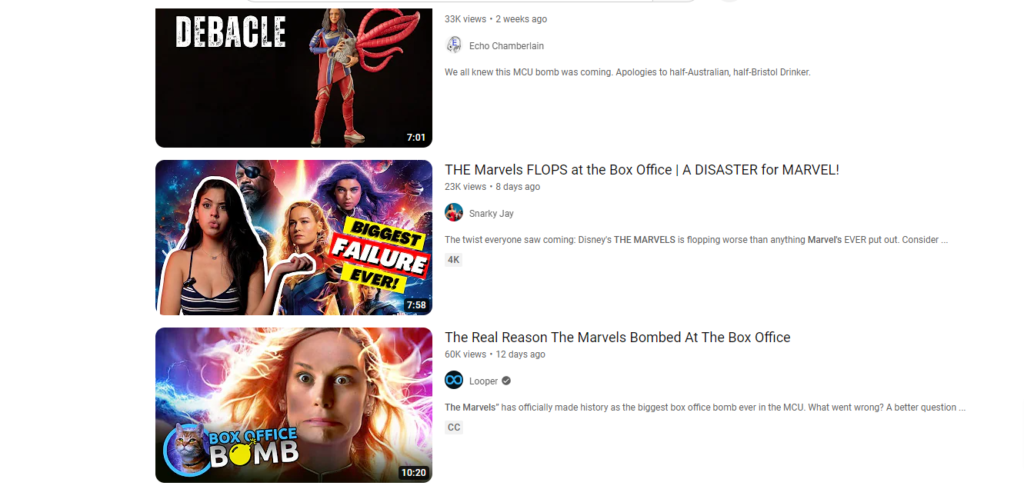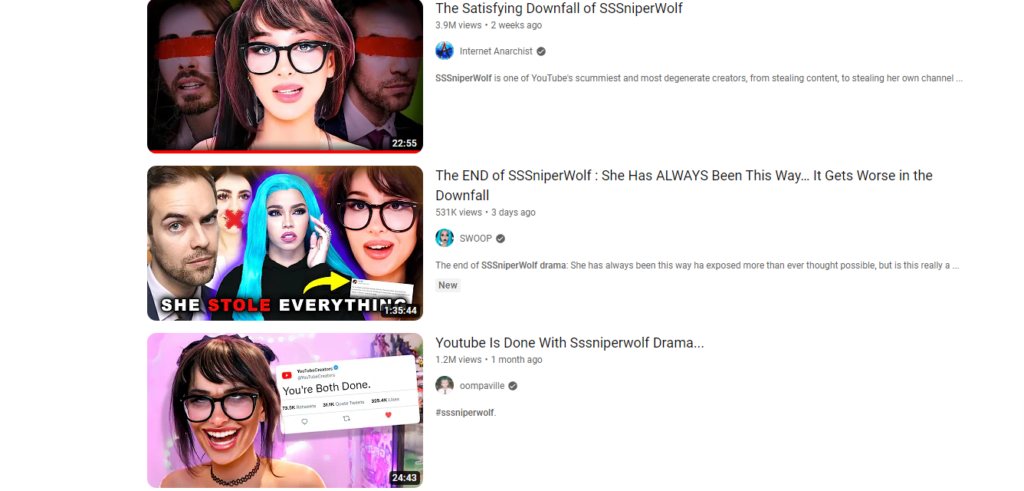
In the ever-evolving landscape of online content creation, influencers and YouTubers often find themselves under the scrutiny of their audiences. Recently, one prominent figure, SSSniperWolf, whose real name is Lia Shelesh, has become the epicentre of controversy. Known for her gaming videos and vlogs, SSSniperWolf has faced a barrage of criticism and backlash for her alleged involvement in a practice that has long lingered in the shadows of the digital realm – content copying.
The storm surrounding SSSniperWolf escalated when accusations of imitating and replicating content began to circulate, leading to a cascade of disapproval from her once-loyal followers. However, this controversy is not merely an isolated incident; it serves as a revealing spotlight on a deep-seated tradition within the content creation industry.
Before delving into the intricate details of SSSniperWolf’s downfall, it is crucial to address a concerning incident that marked a significant low in her online journey. The YouTuber faced severe criticism for allegedly stalking another content creator’s house and filming the premises, a move that not only crossed ethical boundaries but also intensified the growing discontent against her.

This article does not seek to endorse or excuse such actions; rather, it aims to explore the broader implications of SSSniperWolf’s controversy. Beyond the individual missteps lies a much larger industry trend that has persisted for years – the art of content copying.
Join us as we navigate the shadows cast by SSSniperWolf’s recent controversies, shedding light on an industry-wide practice that, while less overt, has been a prevalent force shaping the digital content landscape.
SSSniperWolf’s Controversy
Allegations of Content Copying
In the realm of digital content creation, originality is often hailed as a virtuous trait. However, the spotlight turned harshly on SSSniperWolf when accusations of content copying surfaced. Specific instances emerged where she was accused of replicating content from fellow creators, raising eyebrows and generating a significant level of discontent within the online community. From gameplay videos to vlogs, allegations of unoriginality began to stain SSSniperWolf’s once-pristine reputation.
The evidence supporting these claims was shared widely across social media platforms, with side-by-side comparisons highlighting striking similarities between SSSniperWolf’s content and that of other creators. As the accusations gained traction, a wave of disappointment rippled through her fan base, prompting a reassessment of their allegiance to the popular YouTuber.
Backlash and Criticism
The fallout was swift and intense. SSSniperWolf found herself at the receiving end of a torrent of criticism from her audience, as well as fellow content creators who condemned what they perceived as a breach of creative integrity. Comments sections on her videos were flooded with expressions of disappointment, anger, and calls for accountability. The once-vibrant community that had supported her for years was now fractured, with some fans distancing themselves from the controversy while others vehemently defended their idol.
Notable personalities within the online content creation sphere also weighed in, expressing their concern for the state of originality within the community. This public denouncement from peers added another layer to the narrative, highlighting the broader implications of content creators emulating each other’s work.
The Stalking Incident
As the controversy surrounding content copying unfolded, another alarming incident escalated the public’s disapproval of SSSniperWolf. Accusations arose that she had engaged in the invasive act of stalking another YouTuber’s house, filming the premises without consent, and sharing it with her audience. This step over the ethical line added fuel to the already raging fire of criticism.
In response to the backlash, SSSniperWolf promptly removed the contentious content and issued statements acknowledging the inappropriateness of her actions. Despite these efforts to mitigate the damage, the incident further tarnished her reputation, raising questions about the boundaries and ethical considerations within the online content creation community.
Impact on Reputation
The combined weight of allegations, backlash, and the stalking incident significantly impacted SSSniperWolf’s reputation. The YouTuber, who had once enjoyed a sizable and dedicated following, witnessed a notable decline in subscriber count and faced the loss of brand partnerships. Beyond the individual consequences, her controversy stirred a broader conversation about the responsibilities and expectations placed on influencers and the consequences of ethical lapses in the digital age.
The ensuing chapters will delve into the larger industry trend that SSSniperWolf’s controversy illuminates, examining the practice of content copying that extends far beyond this singular case.
The Larger Issue: A Longstanding Industry Trend
Emphasizing Non-Endorsement of Unethical Practices
Before delving into the pervasive trend of content copying, it is crucial to reiterate that this article does not seek to condone or excuse the actions of SSSniperWolf. Stalking, content copying, and other questionable practices remain widely criticized within the digital content creation sphere. Instead, our aim is to use SSSniperWolf’s controversy as a lens through which to explore a more subtle, yet longstanding, trend within the industry.
Introduction to Content Copying as a Tradition
Beyond the sensationalized headlines and public outcry lies a less overt but deeply rooted tradition within the content creation industry – the practice of content copying. While SSSniperWolf’s case brought this issue to the forefront, it is essential to recognize that she is not an isolated example. The creative boundary between inspiration and imitation has long been blurred, and the line between respectful adaptation and blatant replication has become increasingly difficult to discern.
The Art of Content Copying
Content creators, driven by the ever-present pressure to produce engaging and trending material, often find themselves navigating a delicate balance. The allure of emulating successful formulas, be it in video formats, presentation styles, or topic choices, can be strong. This practice extends across various platforms, including YouTube, TikTok, and other content-sharing spaces.
While not every instance of inspiration should be equated with wrongdoing, the ethical considerations surrounding content copying are undeniable. As the online content creation community continues to grow, discussions about intellectual property, originality, and the responsibility of influencers to their audiences become increasingly relevant. Content creators must grapple with the ethical implications of their choices, recognizing that their actions contribute to shaping industry norms.
In the subsequent sections, we will delve into specific examples of content copying across different platforms, shedding light on the nuanced ways in which this industry trend manifests. From YouTube and TikTok to ebooks and website content creation, the echoes of SSSniperWolf’s controversy reverberate, offering a unique opportunity to examine the broader landscape of content creation practices.

YouTube and TikTok Videos: The SSSniperWolf Effect
Content Copying on YouTube and TikTok: Unmasking the Trend
As we delve into the landscape of YouTube and TikTok, the reverberations of SSSniperWolf’s controversy echo loudly. The pursuit of viral content and a surge in follower counts has given rise to a practice that extends beyond mere inspiration – content copying. SSSniperWolf’s case serves as a stark reminder of the intricate web of emulation that exists within the dynamic landscapes of YouTube and TikTok.
The YouTube Paradox: Originality vs. Replication
On YouTube, one of the largest content-sharing platforms, the struggle between originality and replication intensifies. The pressure to create engaging content often leads to a delicate dance between being unique and emulating successful formats, styles, or entire video concepts.
TikTok, fueled by trends and challenges, blurs the lines between inspiration and imitation. The duet feature, allowing users to create side-by-side videos, has contributed to a culture of replication. SSSniperWolf’s controversy prompts creators to reflect on the ethics of adopting popular TikTok trends and challenges without adding a unique perspective.
Courses on Growing Followers: Unveiling the Playbook of Replication
Within the digital landscape, educational avenues for growing followers and increasing views have gained popularity. Some of these courses specifically teach the art of scrutinizing competitors, identifying top-performing content, and replicating it with a personal twist. You’d be surprised how many of your popular channels you love watching use exactly this technique to get you to watch their content.
The Influence of Major Channels: A Domino Effect of Replication
Examining major YouTube channels such as IGN, Kotaku, EuroGamer, and others reveals a curious phenomenon. These channels often present similar news, opinions, and reviews that resonate with audiences. Smaller channels, aspiring to achieve the same impact on followers and views, frequently adopt a similar approach. This trend is not confined to gaming; it extends across various niches where success has set a template for emulation. They just have a better way of hiding it than SSSniperWolf did.
The Controversy Cash-In: A Meta-Reflection of Replication
Even discussions around SSSniperWolf’s controversy exemplify this replication technique. Popular channels dissecting what happened to SSSniperWolf often follow a similar format, presenting news, opinions, and analyses akin to established players in the field. This meta-reflection underscores the broader industry trend of content creators adopting proven formulas for the promise of impact.
In the subsequent sections, we’ll explore how the replication trend extends beyond video platforms, influencing content creation in other digital spaces, including ebooks and website content. The shadows cast by SSSniperWolf’s controversy reveal a multifaceted landscape where the quest for originality intersects with the pressure to conform to proven formulas.

Ebooks and Popular Topics: Crafting Success in the Shadows
The Allure of Ebooks and Popular Topics
Transitioning from the visual landscapes of YouTube and TikTok, we venture into the realm of written content, specifically ebooks. In this sphere, the quest for success often revolves around tapping into popular topics that resonate with a broad audience. The shadows cast by SSSniperWolf’s controversy extend into the world of ebook creation, shedding light on a practice that has silently thrived for years.
Creating Ebooks Based on Popular Amazon Topics
Enter the digital marketplace giant, Amazon. The popularity of ebooks has given rise to a strategy where creators aim to strike gold by crafting content around topics trending on the platform. This approach is not unique; rather, it is a reflection of a broader trend where content creators seek to replicate success by aligning with what’s already proven to be popular.
As an illustration of this trend, Celenic Earth Publications has collaborated with ebook creators, recognizing the importance of creating ebooks based on popular Amazon topics. The success of this strategy lies in understanding the pulse of the audience and tailoring content to meet their preferences. This approach, while effective, raises questions about the ethical considerations surrounding the replication of popular topics for personal gain.
The Ethical Dilemma: Balancing Success and Originality
The challenge arises when creators navigate the fine line between leveraging popular topics for success and sacrificing originality. While ebooks based on trending themes often garner attention and sales, the industry must grapple with the ethical implications of perpetuating a cycle where creators mimic successful formulas rather than pushing the boundaries of creativity.
The Broader Landscape: Beyond Amazon’s Shores
This trend is not exclusive to Amazon; it extends to other digital marketplaces and platforms where ebooks find a home. The allure of replicating successful ebook structures, themes, and topics becomes a common strategy for those seeking to make an impact in the competitive world of digital publishing.
In the upcoming sections, we’ll unravel how this replication trend permeates the creation of online content for websites, exploring its implications on authenticity, creativity, and the evolving landscape of digital media. The shadows cast by SSSniperWolf’s controversy reveal a complex web where the desire for success intersects with the challenges of maintaining originality.

Online Content for Websites: The Endless Cycle of Trend Replication
The Pervasive Trend: Content Copying in Website Creation
Shifting our focus from the confines of digital marketplaces and ebooks, we enter the sprawling landscape of online content for websites. Here, the practice of content copying takes on a new form, manifesting as a ubiquitous strategy employed by countless websites seeking to capture the elusive attention of online audiences. The shadows cast by SSSniperWolf’s controversy unveil a landscape where the replication of trending content is not just common—it’s ingrained.
The Mechanism of Replication: Platforms, Trends, and Tags
Behind the scenes, the replication game is intricate and systematic. Websites leverage platforms like Feedly, Google Trends, Twitter tags, and more to identify what is trending or breaking out. The allure of cashing in on the same news, stories, or topics that have already proven popular becomes a driving force. This phenomenon is not just a consequence of creative drought but a deliberate strategy to align with what has already captured the online audience’s attention.
SEO Methods and the Replication Game: A Double-Edged Sword
Within the realm of website creation, content copying stands as one of the top SEO methods taught to increase views. The strategy is simple yet powerful: identify what is trending or breaking, replicate it, and reap the benefits of heightened visibility. Companies look for keywords with high search volumes, and then create content around them similar to competitors ranking on top of searches that draw you in and increase traffic or buy products.
This approach is not confined to a niche; rather, it permeates various industries where the replication of popular content becomes a tried-and-tested formula for SEO success.
Personal Experience: The Dichotomy of Advice
Speaking from personal experience, Celenic Earth Publications has encountered the dichotomy of advice within the SEO landscape. The imperative to replicate trending content is not merely theoretical; it’s a pragmatic strategy recommended by some of our clients seeking to enhance their site’s visibility. The challenge arises when this strategy, while effective, blurs the lines between genuine reporting and the replication of news solely for SEO gains.
The Broader Impact: Authenticity vs. Visibility
As websites engage in the replication game, a critical question emerges: at what cost? While the strategy undoubtedly enhances visibility, it simultaneously poses a threat to the authenticity of online content. The constant regurgitation of the same news across multiple platforms dilutes the uniqueness and individuality that each website should ideally bring to its audience.
In the final section, we’ll draw conclusions from the exploration of these various replication trends, examining the overarching impact on the digital content creation landscape. The shadows cast by SSSniperWolf’s controversy reveal a complex web where the pursuit of visibility often clashes with the imperative of maintaining authentic and original storytelling.

Conclusion: Unveiling Shadows in the Digital Landscape
In the labyrinth of online content creation, the controversy surrounding SSSniperWolf serves as a cautionary tale, a vivid illustration of how a creator’s quest for visibility can lead to a perilous dance on the edge of ethical boundaries. Before we draw the curtain on this exploration, it is essential to reiterate our stance: what SSSniperWolf did, particularly the allegations of content copying and the invasive incident of stalking, went too far and is unequivocally condemned. Hers was a clear-cut copy of a specific creator, and a vast war raging about who the original creator of that type of content was.
However, the shadows cast by SSSniperWolf’s actions have illuminated a far-reaching trend that transcends individual missteps. It is a trend not exclusive to the gaming community or YouTube but one that infiltrates the very fabric of digital content creation across platforms and industries.
The replication of popular content, be it in videos, ebooks, or website articles, is not a new phenomenon. It’s a practice that has silently thrived for decades, evolving alongside the digital landscape. SSSniperWolf’s controversy merely brought this longstanding tradition to the forefront, forcing us to confront the undeniable reality that content creators, big and small, have been navigating a delicate balance between inspiration and replication for years.
Even as we engage in this discussion, we recognize the paradox that our very exploration of SSSniperWolf’s controversy is an example of gaining traction from a trending topic. It underscores the complexity of the digital landscape, where discussions surrounding controversial figures become part of a larger cycle of content creation and consumption.
In peeling back the layers of this trend, from YouTube videos to ebooks and website content, our intention is not to point fingers or lay blame indiscriminately. Instead, we seek to shed light on an industry-wide phenomenon that demands introspection and consideration. The replication of successful content is a double-edged sword, offering visibility and success at the cost of diluting the authenticity and creativity that should define content creation.
As we navigate the intricate web of inspiration and imitation, let this serve as a call to action. Let content creators, industry stakeholders, and audiences alike engage in conversations that transcend the allure of replication and instead champion originality, innovation, and ethical content creation.
The shadows have been unveiled, revealing a digital landscape where the pursuit of visibility often collides with the imperative of maintaining authentic and original storytelling. May this revelation ignite a collective commitment to shaping a digital future where creativity thrives without compromise.


